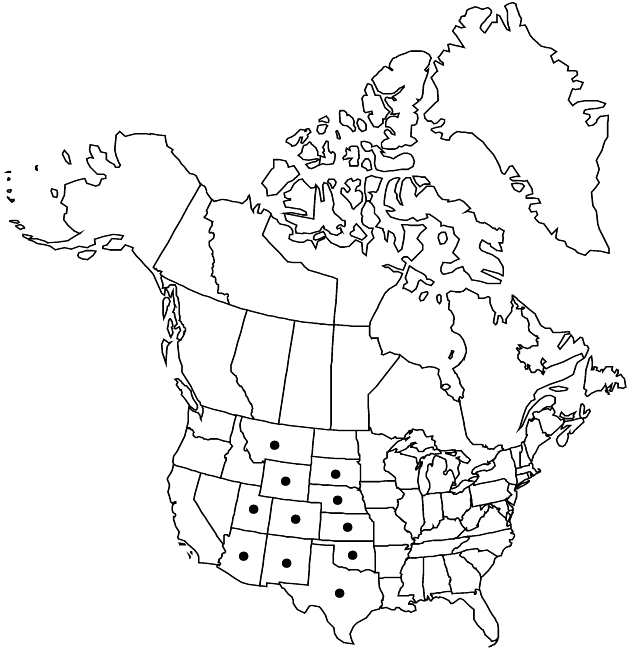Difference between revisions of "Erigeron bellidiastrum"
Trans. Amer. Philos. Soc., n. s. 7: 307. 1840.
FNA>Volume Importer |
RevisionBot (talk | contribs) m (Bot: Adding category Revised Since Print) |
||
| (8 intermediate revisions by 3 users not shown) | |||
| Line 8: | Line 8: | ||
}} | }} | ||
|common_names=Sand fleabane | |common_names=Sand fleabane | ||
| + | |special_status={{Treatment/ID/Special_status | ||
| + | |code=F | ||
| + | |label=Illustrated | ||
| + | }} | ||
|basionyms= | |basionyms= | ||
|synonyms= | |synonyms= | ||
| Line 17: | Line 21: | ||
}}<!-- | }}<!-- | ||
| − | --><span class="statement" id="st-undefined" data-properties=""><b>Annuals </b>(or biennials?), 3.5–30(–50) cm; taprooted. <b>Stems</b> erect to ascending, hirsutulous (hairs upcurved), usually eglandular, sometimes minutely glandular (var. arenarius). <b>Leaves</b> basal (sometimes persistent) and cauline or mostly cauline; blades linear to oblanceolate or spatulate, 10–60(–80) × 2–6(–9, or 15) mm, margins entire, lobed, or pinnately dissected, faces sparsely strigose, eglandular. <b>Heads</b> 1–12 usually in diffuse arrays (from branches beyond midstems or sometimes clustered distally). <b>Involucres</b> 3–5 × 5–7(–11) mm. <b>Phyllaries</b> in 2–3(–4) series, hispidulous, minutely glandular. <b>Ray</b> florets 22–70 (some positioned among inner phyllaries); corollas white, often with abaxial lilac midstripe, drying white to bluish, 4–7.5 mm, laminae not coiling or reflexing. <b>Disc</b> corollas 2.2–3 mm (throats indurate and inflated). <b>Cypselae</b> 1–1.6(–1.8) mm, 2-nerved, faces sparsely strigose; pappi: outer cartilaginous crowns, inner of 15–18 bristles.</span><!-- | + | --><span class="statement" id="st-undefined" data-properties=""><b>Annuals </b>(or biennials?), 3.5–30(–50) cm; taprooted. <b>Stems</b> erect to ascending, hirsutulous (hairs upcurved), usually eglandular, sometimes minutely glandular (<i></i>var.<i> arenarius</i>). <b>Leaves</b> basal (sometimes persistent) and cauline or mostly cauline; blades linear to oblanceolate or spatulate, 10–60(–80) × 2–6(–9, or 15) mm, margins entire, lobed, or pinnately dissected, faces sparsely strigose, eglandular. <b>Heads</b> 1–12 usually in diffuse arrays (from branches beyond midstems or sometimes clustered distally). <b>Involucres</b> 3–5 × 5–7(–11) mm. <b>Phyllaries</b> in 2–3(–4) series, hispidulous, minutely glandular. <b>Ray</b> florets 22–70 (some positioned among inner phyllaries); corollas white, often with abaxial lilac midstripe, drying white to bluish, 4–7.5 mm, laminae not coiling or reflexing. <b>Disc</b> corollas 2.2–3 mm (throats indurate and inflated). <b>Cypselae</b> 1–1.6(–1.8) mm, 2-nerved, faces sparsely strigose; pappi: outer cartilaginous crowns, inner of 15–18 bristles.</span><!-- |
-->{{Treatment/Body | -->{{Treatment/Body | ||
| − | |distribution= | + | |distribution=Ariz.;Colo.;Kans.;Mont.;N.Mex.;Nebr.;Okla.;S.Dak.;Tex.;Utah;Wyo.;n Mexico. |
|discussion=<p>Varieties 3 (3 in the flora).</p><!-- | |discussion=<p>Varieties 3 (3 in the flora).</p><!-- | ||
| − | --><p>Erigeron bellidiastrum is recognized by its annual duration, upcurved hairs of the stem, relatively few rays, 1-seriate pappi, and by some ray florets consistently produced between the phyllaries, the mature cypselae of these held in place as the phyllaries reflex at maturity.</p> | + | --><p><i>Erigeron bellidiastrum</i> is recognized by its annual duration, upcurved hairs of the stem, relatively few rays, 1-seriate pappi, and by some ray florets consistently produced between the phyllaries, the mature cypselae of these held in place as the phyllaries reflex at maturity.</p> |
|tables= | |tables= | ||
|references= | |references= | ||
| Line 53: | Line 57: | ||
-->{{#Taxon: | -->{{#Taxon: | ||
name=Erigeron bellidiastrum | name=Erigeron bellidiastrum | ||
| − | |||
|authority=Nuttall | |authority=Nuttall | ||
|rank=species | |rank=species | ||
| Line 60: | Line 63: | ||
|basionyms= | |basionyms= | ||
|family=Asteraceae | |family=Asteraceae | ||
| − | |distribution= | + | |distribution=Ariz.;Colo.;Kans.;Mont.;N.Mex.;Nebr.;Okla.;S.Dak.;Tex.;Utah;Wyo.;n Mexico. |
|reference=None | |reference=None | ||
|publication title=Trans. Amer. Philos. Soc., n. s. | |publication title=Trans. Amer. Philos. Soc., n. s. | ||
|publication year=1840 | |publication year=1840 | ||
| − | |special status= | + | |special status=Illustrated |
| − | |source xml=https:// | + | |source xml=https://bitbucket.org/aafc-mbb/fna-data-curation/src/2e0870ddd59836b60bcf96646a41e87ea5a5943a/coarse_grained_fna_xml/V19-20-21/V20_777.xml |
|tribe=Asteraceae tribe Astereae | |tribe=Asteraceae tribe Astereae | ||
|genus=Erigeron | |genus=Erigeron | ||
| Line 71: | Line 74: | ||
}}<!-- | }}<!-- | ||
| − | -->[[Category:Treatment]][[Category:Erigeron]] | + | --> |
| + | |||
| + | [[Category:Treatment]] | ||
| + | [[Category:Erigeron]] | ||
| + | [[Category:Revised Since Print]] | ||
Latest revision as of 18:26, 6 November 2020
Annuals (or biennials?), 3.5–30(–50) cm; taprooted. Stems erect to ascending, hirsutulous (hairs upcurved), usually eglandular, sometimes minutely glandular (var. arenarius). Leaves basal (sometimes persistent) and cauline or mostly cauline; blades linear to oblanceolate or spatulate, 10–60(–80) × 2–6(–9, or 15) mm, margins entire, lobed, or pinnately dissected, faces sparsely strigose, eglandular. Heads 1–12 usually in diffuse arrays (from branches beyond midstems or sometimes clustered distally). Involucres 3–5 × 5–7(–11) mm. Phyllaries in 2–3(–4) series, hispidulous, minutely glandular. Ray florets 22–70 (some positioned among inner phyllaries); corollas white, often with abaxial lilac midstripe, drying white to bluish, 4–7.5 mm, laminae not coiling or reflexing. Disc corollas 2.2–3 mm (throats indurate and inflated). Cypselae 1–1.6(–1.8) mm, 2-nerved, faces sparsely strigose; pappi: outer cartilaginous crowns, inner of 15–18 bristles.
Distribution

Ariz., Colo., Kans., Mont., N.Mex., Nebr., Okla., S.Dak., Tex., Utah, Wyo., n Mexico.
Discussion
Varieties 3 (3 in the flora).
Erigeron bellidiastrum is recognized by its annual duration, upcurved hairs of the stem, relatively few rays, 1-seriate pappi, and by some ray florets consistently produced between the phyllaries, the mature cypselae of these held in place as the phyllaries reflex at maturity.
Selected References
None.
Lower Taxa
Key
| 1 | Basal and proximal cauline leaf margins deeply dentate to pinnately lobed | Erigeron bellidiastrum var. arenarius |
| 1 | Basal and proximal cauline leaf margins entire or rarely with pair of shallow teeth | > 2 |
| 2 | Proximal stems mostly 1–2(–2.5) mm wide; basal and proximal cauline leaf blades linear to linear-oblanceolate, 10–15(–30) × 1–2.5(–3) mm | Erigeron bellidiastrum var. bellidiastrum |
| 2 | Proximal stems mostly (2–)2.5–5 mm wide; basal and proximal cauline leaf blades oblanceolate, 20–40(–60) × 3–5(–15) mm | Erigeron bellidiastrum var. robustus |